paleomaxx
Hero Member
- Aug 14, 2016
- 841
- 6,887
- 🥇 Banner finds
- 6
- Detector(s) used
- Deus XP
- Primary Interest:
- All Treasure Hunting
Sites like these are precisely why I spend so much time wandering the woods and pouring over old maps. There was a blip on one of the Beers maps, but there were no roads leading to it and no distinct natural features to orient to. I had good luck at my old sites this past weekend and I debated spending more time gridding them, but I've been meaning the find this site for awhile now and the weather simply couldn't be beat, so I elected to do some hiking.
It's a large section of woods, and after following some streams I hiked up a steep slope to find a series of rock walls. I followed the strongest wall over the crest of the hill and just down the other side was the cellar hole; perched on the edge of the hill! I fired up the detector and immediately started getting hit after hit, some only an inch underground. This site had never been detected before!
I spend three hours there and I know I barely scratched the surface, but it's a long hike back so I packed up and headed out of the woods with the promise to return. Here's just the first round of iron that I hiked out:
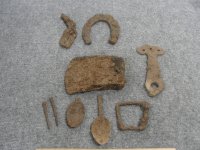
There are quite a few more large pieces that I'll hike out bit by bit ( a 2 foot scythe and a large iron stove grate for instance) but these are a good start. There's also my favorite iron find:
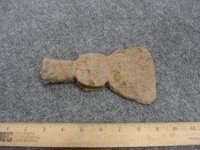
I finally dug a shingling hatchet! I've seen these posted from time to time and I love the shape, plus it's a new style for the axe head collection!
There were also a good number of different oil lamp assemblies.
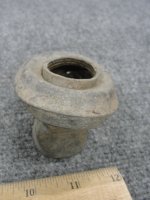
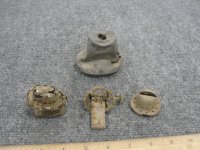
The first piece is pewter and looks like an oil reservoir to a lamp, but I'm curious if someone here knows differently. Oddly this piece was right on the surface under the leaf litter and looks like it was sawed off a larger piece many years back.
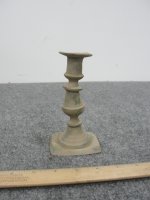
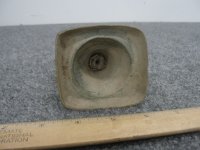
I was so excited to find this; I can't believe they lost an entire candlestick holder! The stem and base are a little loose, but has a beautiful green patina and these don't seem to turn up often at homesites.
There were quite a few coins scattered around and many were just under the surface.
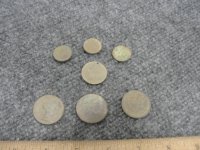
The 1844 large cent was in the best condition; but there was also a draped bust large cent.
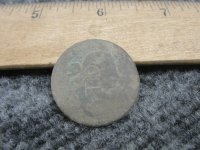
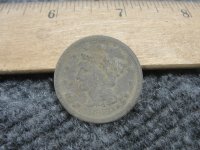
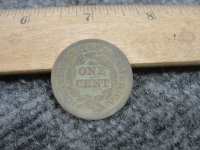
No date, but interestingly the DBLC has a counter-stamp: "TD" I know there are tons of different counter-stamps out there, but does anyone know about this particular one?
There was one other large copper, but it has almost no features left besides the faint outline of a right-facing bust. What's intriguing is that the edge is reeded:
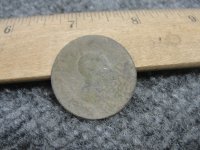
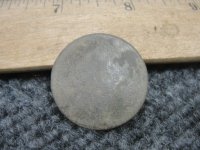
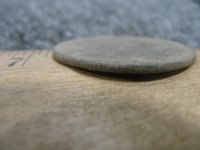
I didn't know of any large coppers with reeded edges before now, so I'm definitely lost on this one.
There were three small coppers as well:
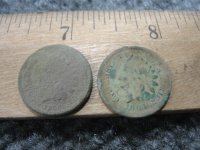
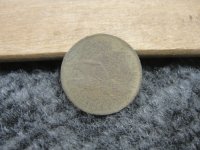
An 1864 bronze IHP, an 1860 or 1864 cupro-nickel IHP, and an 1858 Flying Eagle cent!
The last isn't a coin, but a commemorative medal and my favorite find of the hunt:
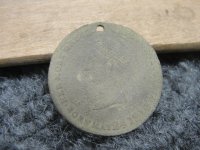
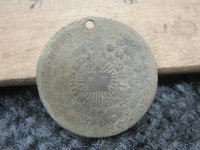
It's a Queen Victoria Coronation medal. The ground was fairly rough on it, but the front has "Born May 24, 1819" and the reverse has "Crowned June 28, 1838" and "Ascended the British Throne June 20, 1837" around the rim. I didn't even know these existed, much less expected to dig one, but it's a fascinating piece of history. I imagine it made it's way down from Canada and I can only guess as to why it ended up at this particular site.
There were quite a few of the other usual homesite relics:
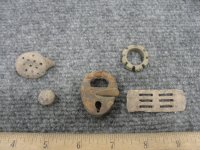
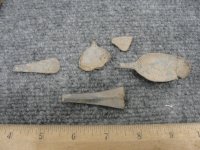
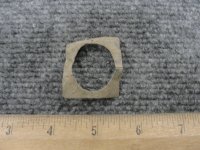
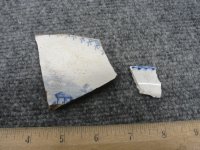
The miniature padlock was a surprise and a good reason to dig scratchy iron/non-ferrous signals. The zinc piece with holes appears to be a musical reed of some sort, but this is a new style to me. The salt-shaker top is pewter, and of course the ubiquitous parasol slide which was actually the first relic I dug! There were a number of pewter spoon fragments including one with a maker's mark: "C. Parker & Co." which is common for this area and date from 1840 to 1880. I also managed to save a very dainty brass rim to a daguerreotype picture box.
I also managed a very nice crotal bell:
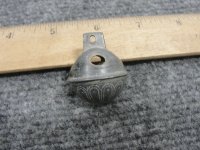
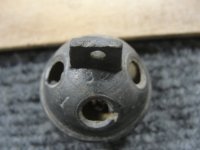
It came out of the ground just as shiny as you see it, and is in fantastic condition. Oddly it has a very faint "3" "2" and a "1" hand-engraved into the top near the stem. It doesn't look as neat as the usual identifying marks on these bells, so maybe leftover casting marks that they meant to remove.
There was also this brass wheel that looks like a broken pulley wheel.
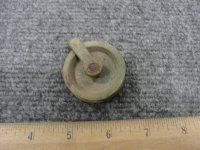
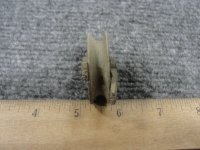
This was just the first-pass of the site mostly focusing on the areas directly adjacent to the cellar hole. I did find the trash pit and that alone will be tons to dig out, but I can't even imagine what else is still in the ground. No silver in this round, but with so many coins I'm certain that I'll find a few pieces hiding under the large signals and there are miles of fields (now forest) that I can hunt as well. This will be a fantastic series of hunts so stay tuned!
It's a large section of woods, and after following some streams I hiked up a steep slope to find a series of rock walls. I followed the strongest wall over the crest of the hill and just down the other side was the cellar hole; perched on the edge of the hill! I fired up the detector and immediately started getting hit after hit, some only an inch underground. This site had never been detected before!
I spend three hours there and I know I barely scratched the surface, but it's a long hike back so I packed up and headed out of the woods with the promise to return. Here's just the first round of iron that I hiked out:

There are quite a few more large pieces that I'll hike out bit by bit ( a 2 foot scythe and a large iron stove grate for instance) but these are a good start. There's also my favorite iron find:

I finally dug a shingling hatchet! I've seen these posted from time to time and I love the shape, plus it's a new style for the axe head collection!
There were also a good number of different oil lamp assemblies.


The first piece is pewter and looks like an oil reservoir to a lamp, but I'm curious if someone here knows differently. Oddly this piece was right on the surface under the leaf litter and looks like it was sawed off a larger piece many years back.


I was so excited to find this; I can't believe they lost an entire candlestick holder! The stem and base are a little loose, but has a beautiful green patina and these don't seem to turn up often at homesites.
There were quite a few coins scattered around and many were just under the surface.

The 1844 large cent was in the best condition; but there was also a draped bust large cent.



No date, but interestingly the DBLC has a counter-stamp: "TD" I know there are tons of different counter-stamps out there, but does anyone know about this particular one?
There was one other large copper, but it has almost no features left besides the faint outline of a right-facing bust. What's intriguing is that the edge is reeded:



I didn't know of any large coppers with reeded edges before now, so I'm definitely lost on this one.
There were three small coppers as well:


An 1864 bronze IHP, an 1860 or 1864 cupro-nickel IHP, and an 1858 Flying Eagle cent!
The last isn't a coin, but a commemorative medal and my favorite find of the hunt:


It's a Queen Victoria Coronation medal. The ground was fairly rough on it, but the front has "Born May 24, 1819" and the reverse has "Crowned June 28, 1838" and "Ascended the British Throne June 20, 1837" around the rim. I didn't even know these existed, much less expected to dig one, but it's a fascinating piece of history. I imagine it made it's way down from Canada and I can only guess as to why it ended up at this particular site.
There were quite a few of the other usual homesite relics:




The miniature padlock was a surprise and a good reason to dig scratchy iron/non-ferrous signals. The zinc piece with holes appears to be a musical reed of some sort, but this is a new style to me. The salt-shaker top is pewter, and of course the ubiquitous parasol slide which was actually the first relic I dug! There were a number of pewter spoon fragments including one with a maker's mark: "C. Parker & Co." which is common for this area and date from 1840 to 1880. I also managed to save a very dainty brass rim to a daguerreotype picture box.
I also managed a very nice crotal bell:


It came out of the ground just as shiny as you see it, and is in fantastic condition. Oddly it has a very faint "3" "2" and a "1" hand-engraved into the top near the stem. It doesn't look as neat as the usual identifying marks on these bells, so maybe leftover casting marks that they meant to remove.
There was also this brass wheel that looks like a broken pulley wheel.


This was just the first-pass of the site mostly focusing on the areas directly adjacent to the cellar hole. I did find the trash pit and that alone will be tons to dig out, but I can't even imagine what else is still in the ground. No silver in this round, but with so many coins I'm certain that I'll find a few pieces hiding under the large signals and there are miles of fields (now forest) that I can hunt as well. This will be a fantastic series of hunts so stay tuned!
Last edited:
Upvote
51






